#inspired by paprika (2006)
Explore tagged Tumblr posts
Text
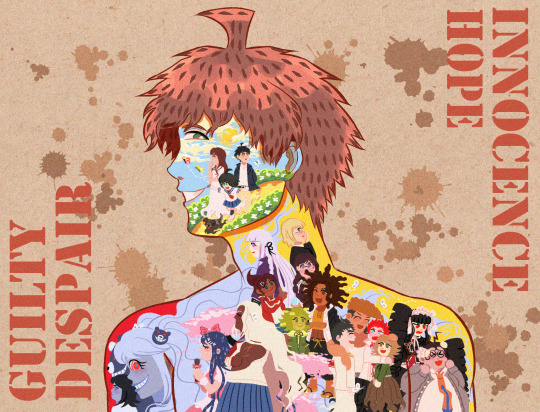
"I'm going to carry them with me the rest of my life. I'll carry them with me forever. I'll carry their memories with me wherever I go!"
- Makoto Naegi
#inspired by paprika (2006)#danganronpa#danganronpa fanart#fanart#chirpos pencil#makoto naegi#kyoko kirigiri#byakuya togami#aoi asahina#toko fukawa#yasuhiro hagakure#junko enoshima#class 78#komaru naegi#naegi family
344 notes
·
View notes
Text
get to know me
Tag people you want to get to know better!
tagged by: @mashamorevvna 💖✨Thank you so much for the tag. I adore your writing and your posts.
tagging: @cuideag @bizzyfish @nnairdav @speltfields @unkledeath @picklelee @mandibles0322 if you'd like to join :)
Last song: "The Mad Stone" -- Everything Everything
Currently Watching: I don't really watch shows anymore but I've finally been listening to the Magnus Archives.
Three Ships:
1) Kakyoin Noriaki/Kujo Jotaro (JJBA) These two got me into reading fanfic.
2) Varré/Tarnished (Elden Ring) These two got me to interact with fanfic and writers.
3) Dark Urge/Enver Gortash (BG3) These two inspired me to write my own fanfic.
Favorite Color: Dark greyish green, Deep navy blue with gold accents, and/or Rich Burgundy
Currently Consuming: London Fog tea with honey and a splash of cream
First Ship: Tenou Haruka/Kaiou Michiru
Place of Birth: A riverside town in Kentucky
Currently Location: Florida (the storms are lovely, the beach is nice, I'd love to live near mountains though)
Relationship Status: Taken
Pets: I have two cats, Anri and Fia
Last Movie: Paprika (2006) dir. Satoshi Kon.
Currently Working On:
1) Writing - Hound of Bane WIP (explicit, Dark Urge/Gortash, M/M)
2) Art - More bg3 npc mochis
10 notes
·
View notes
Text
Paprika, Inception and the Triumph of the West
The last film directed by Satoshi Kon, Paprika, is a wonderful movie, the plot about getting into dreams with a technologic device is simply mind breaking, the artwork and animation are top quality, the soundtrack fits the theme of the movie, and the characters are well designed both in their identity and story. It was a pioneer of its kind, and it is considered as one of the best anime movies. On the other hand, Inception is also a terrific movie, it has a cast of recognized and quality actors, a beautiful cinematography, and an impeccable work of visual effects.
The anime movie was released in 2006, while the film directed by Cristopher Nolan in 2010. It is obvious, and Nolan acknowledged it, that Inception was inspired by Paprika’s plot. I do not mean that Inception is just plagiarism, but even some frames are taken from Paprika. The whole thing of using a dream sharing technology is straight out Paprika, and the theme of dreams mixed with reality also is.
The point of this text is about a comparison of the recognition and monetary success of both movies. Paprika, as I recently mentioned, is a very recognized movie by the anime fans, but it is not as famous as Inception. When it comes to the profit the movies made, Paprika is not even close to the box office hit of Inception. That been said, I thought about the fact that the cultural barrier between eastern and western film makes a lot harder to an anime production to get the recognition of a western production. This is also consistent with the fact that the film critics usually do not like anime, or do not give anime the recognition it deserves. This can be seen in the number of awards they received, which means nothing to me, but a lot to the spread of a production in the western public.
To end this blog I would like to mention that Paprika is not the only film directed by Satoshi Kon that inspired a box office hit and award winning western movie, meaning that the western film critics are blinded by prejudice about anime productions, and I hope this kind of thinking changes in the future, so that in the future the content of a movie is considered more than the packaging.
-Aquiles Rojas

2 notes
·
View notes
Text
Paprika (2006)
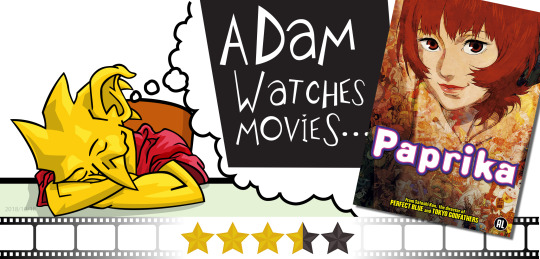
Paprika is a fever dream blast of inspiration that is simultaneously wonderful to behold and nightmare-inducing. It ends on a low note but the trip to that conclusion ensorcels you so completely you may not even care.
In the near future, Doctor Atsuko Chiba (voiced by Megumi Hayashibara) uses the experimental DC Mini device to hop into her patients’ dreams and treat their subconscious using her alter-ego, Paprika. When people exposed to the device, including her boss, Doctor Toratarō Shima (Katsunosuke Hori), start exhibiting erratic behaviour culminating in suicide attempts, Paprika must explore the increasingly bizarre dreams they collectively share to find out who is responsible. How does the strange parade of creatures and living objects connect to her patient, Detective Toshimi Konakawa (Akio Ōtsuka), the scientists responsible for creating the DC Mini, Doctor Kōsaku Tokita (Tōru Furuya), and Kei Himuro (Daisuke Sakaguchi). More importantly, why is this happening?
The medium of animation is perfect for this kind of story. You would need so many special effects to bring the otherworldly sights of the dream world to life it would’ve basically turned into an animated movie anyway. Director Satoshi Kon has so many visual tricks up their sleeve. Paprika’s movements are inhibited only by her imagination. This is shown in the mind-blowing opening scene in which she moves from reflections on windows, to pictures on T-shirts to billboards and anything you could think of to get from one place to another. Many scenes show characters morphing or changing as their consciousness gets sucked into the never-ending parade of weird objects invading everyone’s dreams. When you see it, you don’t know whether to run for the hills screaming or force your eyes open so you don’t miss a second. The colours and creativity in these visuals are so dazzling it doesn’t even matter that sometimes you'll have difficulty understanding the plot.
The film ensnares you in this whirlwind of wonder and unease. You have difficulty differentiating reality from dreams, except when someone wakes up and points out how crazy things were a second ago. That’s the power of this story. And then, we get to the conclusion, which is a major letdown. Not only can you decipher the mastermind behind this big thing based on the character's design, the reason for everything doesn’t really make much sense. You’re left wondering if maybe the translation was bad, or if this story really wasn’t all that good and you were just swept up in all the razzle-dazzle. Ultimately, I say there is more to the film than just what you see. The mystery is compelling and the twist keep you guessing. It’s just everything before the conclusion was so great that when this generic ending comes around, it feels even worse than it is.
The last few minutes of Paprika will split audiences. Either you’ll love it and it’ll become a new favourite, or it’ll leave you with mixed feelings, meaning you’ll be blown away by the movie but content with just seeing it once... maybe two or three times. The sights within are nothing short of incredible so regardless of how you may feel about that finale, it’s worth seeing. (English Dub on DVD, May 24 2019)

#Paprika#movies#films#movie reviews#film reviews#satoshi kon#seishi minakami#megumi hayashibara#toru emori#katsunosuke hori#toru furuya#akio otsuka#koichi yamadera#hideyuki tanaka#2006 movies#2006 films
8 notes
·
View notes
Text
Concept Development 1
While conceptualising my graduate piece, I decided to go with the monster that is ambition.
I spewed my brain onto my notes app, and I wanted to go with a horror-like concept. A few keywords are the Mandela Catalogue ARG, metamorphosis, megalomania, hypnotism themes, corrupted religious imagery (relating back to the Mandela Catalogue), and the butterfly's life cycle.
A few visual inspirations are:
JR's Drawings
Elden Ring
Junji Ito
Creepypastas (Slenderman, Russian Sleep Experiment)
Liquid Lights
Maria Roi
Buerlangma Fall 2023
Uncanny Valley
Paprika (2006)
These are a few key points I was inspired by when first thinking up my graduate show piece.
0 notes
Text












Paprika (Japanese: パプリカ, Hepburn: Papurika) is a 2006 Japanese adult animated surrealistic science fantasy psychological thriller film directed by Satoshi Kon, who co-wrote the screenplay with Seishi Minakami.
The film follows a battle between a "dream terrorist" who causes nightmares by stealing a device that allows others to share their dreams, and a research psychologist who enters the dream world and changes into a dream detective named Paprika to investigate the cases.
Inspiration for the movie 'Inception' by Christopher Nolan
1 note
·
View note
Text
Inspiration Reel for 'Dreaming'
An inspiration reel created for my Animation Pitch to help capture the intended atmosphere of the production.
Music from: Warner Records Story Time · Dario Marianelli Kubo and the Two Strings (Original Motion Picture Soundtrack) ℗ 2016 Two Strings, LLC.
Films featured:
Paprika (2006)
Kubo and the Two Strings (2016)
The Little Prince (2015)
Tekkonkinkreet (2006)
The Eagleman Stag (2011)
Spirited Away (2001)
Chungking Express (1994)
Kiki's Delivery Service (1989)
2 notes
·
View notes
Text
Inception: The Movies and Comics Fans Think It Ripped Off
https://ift.tt/3xIhzbS
They say there’s nothing new under the sun and that Hollywood is bereft of fresh ideas. But sometimes truly innovative films are unfairly accused of being derivative just because they put a new twist on an age old concept. Such is the case with Christopher Nolan’s 2010 film Inception, which is receiving fresh scrutiny now that it’s streaming on Netflix for longtime fans as well as those who missed it in theaters the first time around.
Sometimes the chronology of inspiration doesn’t quite line up as neatly as skeptics would like to think. Even though Inception was released in 2010, Nolan had presented a treatment to Warner Bros. about “dream stealers” in 2002 before shelving it to work on other projects. With that in mind, could the following properties have inspired the Academy Award winning film as some have theorized, and if not, how else could the similarities be explained?
Paprika (2006)
Satoshi Kon’s surreal science fiction anime, Paprika, is often brought up as a possible inspiration for Inception. Even allowing for Nolan’s aforementioned development period, the animated film is actually based on a 1993 novel of the same name, so the fact that an earlier story used a type of technology to induce a shared dream state raises some eyebrows. But how much do these two films really have in common?
Two scenes in Paprika draw particular attention from those who think Nolan stole the idea. One is the use of a hotel corridor that appears to defy the laws of physics. In Inception, the fight scene which follows Joseph Gordon-Levitt’s Arthur as he tries to keep his team alive while the falling van in the dream level above him wreaks havoc with gravity is a hallmark of the movie. Detective Konokawa’s recurring dream is also central to the anime, but the warping floor doesn’t really create the same effect. And honestly, hallways are regular fodder for dream sequences.
The other commonality is more subtle, but it involves breaking open a new area of the dream. Elliot Page experiments with the dreamscape in Inception by swinging a giant mirror between a pair of columns and then shattering it, while the titular character in Paprika widens a cracked opening between two different dreams. Perhaps it’s because both characters wear red and tentatively reach out a hand to the opening that people draw a parallel between the films, but the similarities end there. The chaotic nature of Kon’s dream narrative otherwise bears little resemblance to Nolan’s ordered dream architecture.
Read more
Movies
Inception and the Best Fan Theories About Whether Cobb’s Dreaming
By Michael Ahr
Movies
Inception Ending: Why the Spinner Stopped
By David Crow
The Dream of a Lifetime (2002)
It seems silly to even consider a Donald Duck comic as inspiration for a mind-bender like Inception, but it’s hard to deny the coincidental parallels that appear in Uncle Scrooge #329, published in 2004 in America two years after its Danish release, which was also the same year Nolan presented his treatment. “The Dream of a Lifetime” in this comic also uses a machine to invade Scrooge McDuck’s dream for the purposes of stealing his money.
The similarities are more prevalent in this story, which follows the villainous Beagle Boys as they use a stolen psychiatric tool (which was also how Paprika presented its technology) to extract the safe combination from Scrooge in his dream and steal his fortunes. Inception undeniably also uses a safe combination to entrap its subject, Cillian Murphy’s Fischer, who is heir to his father’s company, and the coincidences don’t end there.
“The Dream of a Lifetime” also presents its set of rules for the dream, just as Inception does. Whereas Nolan’s film talks about deep dreamers getting trapped in Limbo, the comic presents the danger of Scrooge waking up first, which would trap the Beagle Boys inside his mind forever, driving the old miser mad. However, dream subjects in Inception protect themselves with subconscious projections, whereas Scrooge is vulnerable to simply confessing the combination in his open dream state. The presence of rules is similar, but the rules themselves are not. Nolan did not rob Scrooge.
Dreamscape (1984)
Putting aside Freddie Krueger and the “dream warriors” of A Nightmare on Elm Street, the ’80s were filled with movies exploring other planes of existence, and Dreamscape shares a few similarities with Inception and the other properties on this list. The film again presents its dream-sharing technology as a medical tool that is then exploited, but it requires the use of psychic ability as well to enter the minds of others.
At this point, it should be clear that using technology to enter a dream is not a new idea, but Inception certainly can’t be accused of doing anything more than putting a twist on an exploitable core concept. Dreamscape presented a rule that dying while asleep would cause you to die in real life, which Nolan’s film circumvented through its use of Limbo, and other than that, the similarities fade quickly upon closer examination.
Last Year in Marienbad (1961)
Nolan has wisely ignored all accusations that he stole his idea for Inception from earlier works, but he did admit to watching Last Year in Marienbad, a movie with a dreamlike narrative that skips around in time in a very fluid manner. Aside from using another hotel corridor, the film’s story bears no resemblance to Inception, and even though Nolan watched the movie the year his film was released, he knew people would still question his influences.
“Everyone was accusing me of ripping it off, but I actually never got around to seeing it,” he told a New York Times reporter. “Funnily enough, I saw it and I’m like, ‘Oh, wow. There are bits of Inception that people are going to think I ripped straight out of Last Year at Marienbad.”
Fortunately, Nolan realizes it’s all part of a natural process of film analysis some moviegoers thrive on. “Basically, what it means is I’m ripping off the movies that ripped off Last Year at Marienbad, without having seen the original. It’s that much a source of ideas, really, about the relationships between dream and memory and so forth, which is very much what Inception deals with.”
Nolan got the last laugh in the end, though, adding, “But we have way more explosions.”
cnx.cmd.push(function() { cnx({ playerId: "106e33c0-3911-473c-b599-b1426db57530", }).render("0270c398a82f44f49c23c16122516796"); });
The post Inception: The Movies and Comics Fans Think It Ripped Off appeared first on Den of Geek.
from Den of Geek https://ift.tt/3g3hNUR
2 notes
·
View notes
Text
Kenshi Yonezu - Between Pop and Drawings
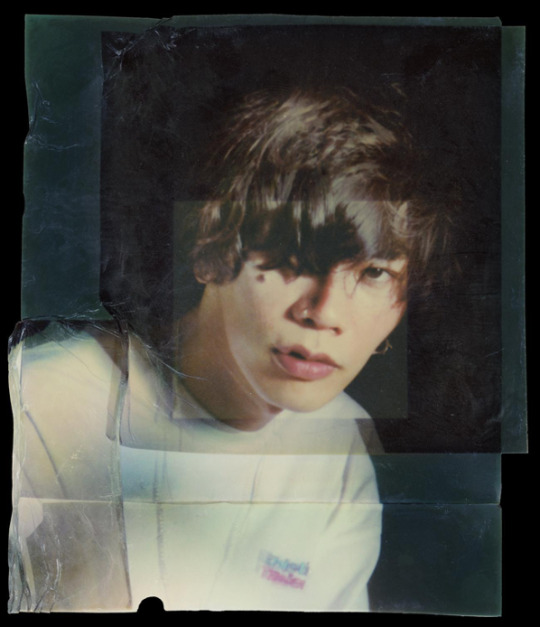
Here I am with the third part of August’s themed week in “Focusing on”! Today’s subject is a Japanese pop artist, who breaks the canon of the genre with simpleness and energy. We’re talking about Kenshi Yonezu, born on 10th March 1991 in the rural area of Tokushima. His first approach to music occurred on 2006, when he created a band with a friend of his, named Late Rabbit Edda, which didn’t get much success. Then, between 2008 and 2009, he started to release Vocaloid tracks on Nico Nico Douga under the stage name Hachi and sometime later he moved to Osaka, where he published other Vocaloid tracks, which became quite popular. On 2009 he officially appeared in a Exit Tunes compilation and in other Vocaloid compilations, boosting his popularity even more, arriving to release two albums of his own, Hanataba to suisou (Bouquets and sea burials) and Official Orange. On 2011 he officially debuted in a major laber as Kenshi Yonezu and since then he built up the concept we got to know, mainly artistic and naturalistic, as he is also a drawer, whose works, inspired by Edward Gorey’s art, are featured in his videoclips and release covers. His genre is an alternative pop-rock, pretty unusual for the canon, where there’s an alternance between upbeat and nostalgical themes, with each song cured by Kenshi himself, in each aspect. His official debut occurred on May 2012, with the release of the first major album Diorama (reviewed here).
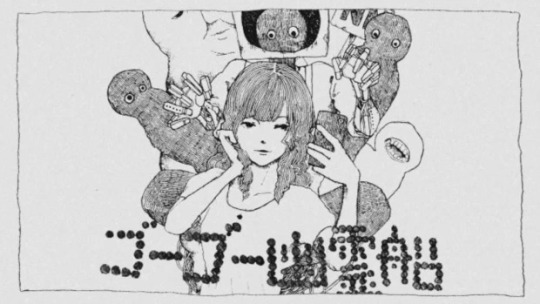
One of the lead-tracks, named Go go yuureisen (Go go ghost ship), sees an extremely positive sound, articulated by good electronic notes and charismatic vocals; the song is about the beginning of a revolution, synonym of a new chapter of Kenshi’s musical path. It has been followed by the singles Santa Maria and Mad Head Love/Popping Apathy, the second album Yankee (reviewed here) and the single Flowerwall.

The title-track has clearer notes, building up an upbeat melody, with a relevant rhythm and Kenshi’s light vocals; the song is about trying to live in happiness and harmony. It has been followed by the single Unbelievers, the third album Bremen and the single Loser/Number Nine.

The first title-track mixes pretty well rock and dance pop, in a catchy sound, driven by energetic vocals and a positive melody; the song is about the bad luck and the defeat in everyday life. It has been followed by the singles Orion and Peace Sign, the fourth album Bootleg and the single Lemon.
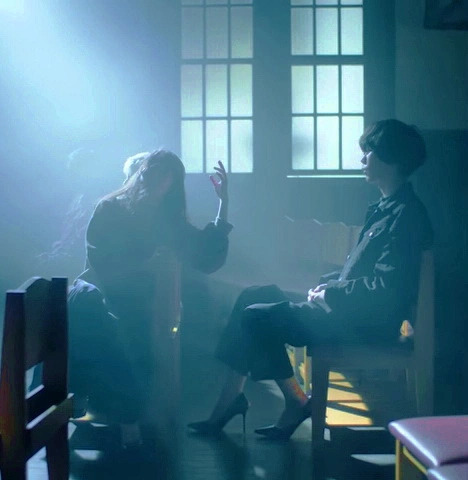
The title-track, featured as theme for the tv series Unnatural, has an intense atmosphere and a nice rock vibe, provided by a good melody and well kept up by Kenshi’s mature vocals (the videoclip has over 600 million views, making it the most viewed musical video in Japan); the song is about loving the life with someone else, even in bad moments. It has been followed by the singles Suna no wakusei (Sand planet), made in duet with Hatsune Miku, Flamingo/Teenage Riot, Umi no yuurei (Spirits of the sea), Uma to shika (Horse and deer) and Paprika.
The Japanese pop scene is incredibly wide and features a lot of acts, some better than others, but mostly calibrated in a certain common direction musically talking. Kenshi Yonezu has been able to subvert any expectation, since he came from the Vocaloid scene and brought a new and refreshing way of doing pop music. Catchy and upbeat themes, alternated to experimentations and melancholic melodies, accompained by Kenshi’s versatile and suggestive vocals, singing really peculiar lyrics, made of nature and feelings; this is how his music can be summarized, redefining the way most people is watching at Japan in terms of music. The presence of his songs in anime themes, dramas and TV spots boosted more his popularity, reaching even oversea audience, thanks to a simpleness which hides something more complex and deeper than expected. Surely Kenshi’s works don’t go unnoticed and that’s a surprising thing, since he relies on mature concepts and a characteristic art behind each his composition, and recently he stepped the game with his newest work, the fifth album Stray Sheep, one of the most awaited releases of this Summer and a really good companion for these troubled times.
Who might enjoy: who is looking for an unusual and riveting pop artist, whose style goes between nature, emotions and nostalgia.
Recommended tracks (as Hachi): World’s End Umbrella, Rinne and Matoryoshka.
Recommended tracks (as Kenshi Yonezu): Go go yuureisen, Vivi, Santa Maria, Flowerwall, Peace Sign, Loser and Lemon.
That’s all folks! See you on the final part of August’s themed week in “Lyrical Love”!
Thanks for the reading!
#kenshi yonezu#jrock#jpop#indie#vocaloid#hachi#catchy#nostalgical#energetic#nature#upbeat#art#focusing on#themed week: august 2020
31 notes
·
View notes
Text
Anime Movies, from my personal collection, for anybody who’s looking to watch something either for entertainment or to find inspiration~
(I put a * symbol next to my favorites)
*Pokemon the 1st Movie (1998), *Pokemon 2000 (1999), Pokemon 3 Spell of the Unknown (2000), *Pokemon 4Ever (2001), Pokemon Heroes (2002), Pokemon Jirachi Wish Maker (2003), Pokemon Destiny Deoxys (2004), Pokemon Lucario and the Mystery of Mew (2005)
*Sailor Moon R Promise of the Rose (1993), Sailor Moon S Hearts in Ice (1994), Sailor Moon SuperS Black Dream Hole (1995)
*DBZ the Dead Zone (1989), *DBZ World’s Strongest (1990), DBZ Lord Slug (1991), DBZ Cooler’s Revenge (1991), *DBZ Return of Cooler (1992), *DBZ Battle of Gods (2014), *DBZ Super Broly (2019)
*Digimon the Movie (2000), *Digimon Revenge of Diaboromon (2001), Digimon Battle of Aadventures (2001), *Digimon Runaway Locomon (2002), *Digimon Island of Lost Digimon (2002)
Inuyasha the Movie Affections Touching Across Time (2001), Inuyasha the Movie the Castle Beyond the Looking Glass (2002), Inuyasha the Movie Swords of an Honorable Ruler (2003)
Cardcaprot Sakura the Movie (1999), Cardcaptor Sakura Movie 2 the Sealed Card (2000)
Tenchi the Movie Tenchi Muyo in Love (1996), Tenchi Forever the Movie (1999)
*Cowboy Bebop the Movie (2001)
Castle in the Sky (1986), *Kiki’s Delivery Service (1989), *Spirited Away (2001), Princess Mononoke (1997), *Howl’s Movies Castle (2004), Grave of the Fireflies (1988), My Neighbor Totoro (1988), Pom Poko (1994), *Porco Rosso (1992), Only Yesterday (1991), The Tale of Princess Kaguya (2013), Ponyo (2008)
The Ringing Bell (1978), *The Sea Prince and the Fire Child (1981), *The Fantastic Adventures of Unico (1981)
*Ghost in the Shell (1995), Ghost in the Shell 2 Innocence (2004)
*Akira (1988)
*Perfect Blue (1997)
*Tokyo Godfathers (2003)
Cat Soup (2001)
Blood the Last Vampire (2000)
Summer Wars (2019)
The Girl who Leapt through Time (2006)
Mind Game (2004)
Millennium Actress (2001)
Steamboy (2005)
Paprika (2007)
Trigun Badlands Rumble (2010)
A Silent Voice (2016)
12 notes
·
View notes
Photo

Paprika
Directed by Satoshi Kon | 90 minutes | (M) | 15th Anniversary Screening
7:00pm, Thursday November 25 | Buy Tickets | Buy Passes
The psychedelic animated film that inspired Christopher Nolan’s Inception.
When a machine that allows therapists to enter their patient's dreams is stolen, all hell breaks loose. Only a young female therapist can stop it: Paprika. A stunning achievement in animation, Paprika cements late director Satoshi Kon's status as a titan of subversive, genre-bending Anime madness.
“In Paprika, a gorgeous riot of future-shock ideas and brightly animated imagery, the doors of perception never close.”- Manohla Dargis, New York Times
Festivals: Venice Film Festival, New York Film Festival, Tokyo International Film Festival, Fantasporo, NZIFF
Country: Japan Year: 2006 Language: Japanese Screens with: Twelve Tales Told (3D)
0 notes
Photo

Paprika
Directed by Satoshi Kon | 90 minutes | (M) | 15th Anniversary Screening
7:00pm, Friday May 14 // 7:30pm, Thursday May 20 | Buy Tickets | Buy Passes
ENCORE SESSION - 7:30pm (AEST), Thurs May 20
OPENING NIGHT SESSION - 7:00pm (AEST), Fri May 14
The psychedelic animated film that inspired Christopher Nolan’s Inception.
When a machine that allows therapists to enter their patient's dreams is stolen, all hell breaks loose. Only a young female therapist can stop it: Paprika. A stunning achievement in animation, Paprika cements late director Satoshi Kon's status as a titan of subversive, genre-bending Anime madness.
“In Paprika, a gorgeous riot of future-shock ideas and brightly animated imagery, the doors of perception never close.”- Manohla Dargis, New York Times
Festivals: Venice Film Festival, New York Film Festival, Tokyo International Film Festival, Fantasporo, NZIFF
Country: Japan Year: 2006 Language: Japanese
1 note
·
View note
Text
All about anime in India
Indians are actually not new to anime; many people may not have realized but they’ve been watching it since their childhood. The famous anime Dragon ball-z, Naruto, Bayblade, Pokemon and even Doraemon and Ninja Hattori are actually Japanese animated series.
The misconception that Japanese anime is just “Cartoon” and is meant for kids is extremely wrong. I agree that anime’s like Doraemon or Ninja Hattori is targeted for children but Japanese anime industry is more than that.
It’s a huge industry! name any genre, and you’ll find a lot of anime series under that. Nowadays, because of the OTT platforms streaming anime’s, the audience in India is more familiar and are watching, and appreciating them.
This industry has created several masterpieces that has actually been adapted by many foreign movies. For example, the movie Inception directed by Christopher Nolan is actually inspired by Paprika a 2006 film directed by legendary Satoshi Kon, the movie Ghost in the Shell directed by Rupert Sanders is remake of an anime movie with the same name. These movies were extremely good, I recommend watching it.
I got into watching anime because of my friend who insisted me to watch Death Note. For my little brain, it was a really intense anime with much psychological study and amazing characters. I never knew that animated things could be such intense, in India we have cartoons like Chota Bheem, Mighty Raju, Motu Patlu etc. I was lucky enough to grow up in the age where the most popular cartoons (which were anime series, but back then I didn’t know) were Bayblade, Pokemon, Digimon etc. These anime’s were more focused on children under the age of 15. But a series like death note which is targeted for 13 and above, completely blew me away. I was getting introduced to a whole another genre. Ever since then, I have explored a lot more anime’s. While some were disappointing, others and majority of them were just masterpieces. Like “Ghost in the Shell” a steel body with the brain of a human, it explores what it really means to be an individual. Another example, one which is my favorite “Monster” written by Naoki Urasawa, is like a psychological character study involving many characters, and all of them are important! as the story progress we see, and empathize with them. Like Johan Liebert, one of the main characters with very less screen time, yet the most important character. He’s a product of psychological experiments done to him when he was a child by the govt to turn small children into perfect soldiers, or Dr Tenma the one who believes in equality of every life yet, wants to eliminate Johan. Another interesting character called Detective Lunge, who’s addicted to his job, and avoids his family because of that. And Eva Heinemann who was initially Dr Tenma’s fiancé but later breaks up with him and blames all her failures on him, she becomes alcoholic, develops hatred towards Tenma yet helps him in several instances, even though we know the bad side of all these people but it’s made in such a way that we are compelled to empathize with them, all of them are very well studied. That’s not it, the story has several sub-plots, all of them are like a philosophical study. It explores the evil and good, human rights, free will, hatred, loneliness and many more. All this is told in a unique way. Another anime called “Paranoia Agent” focusing on Mass Hysteria with such an odd storytelling, every episode new and has different protagonist, its chaotic to watch and of course, is a brain twister. These all anime series are amazing and absolutely worth a watch. We can see the effort put in by the creators and the music composers as well.
Now, you may want to ask if anime’s are so good, then how come its banned in so many countries? Well, there’s always good and a bad side. Sure, there are a lot average and garbage anime as well. But anime’s which are good, should not be overlooked! But we should also address the bad side of it. There’s a lot of anime series with mature content in it, the real reason they get banned anime is because of the sexualization of female characters which resembles as an under 18. These anime series are not mainstream but there is a fair amount anime which features characters who has child-like characteristics and is been sexualized.
This type anime comes under their own genre. But it still falls under an offense. Some countries have been trying to control that as well, by banning only problematic anime’s or all anime series. Some people came up with the argument that since, they’re not real characters it should not matter, if they consume that type of content that does not necessarily mean that they are pedophiles. Personally, I’m not convinced with this argument. But everyone has an opinion.
Obviously, this problem should be handled and all anime shouldn’t be banned since these types of anime does not represent all anime. There are a lot of gem out there that everyone should watch or at least attempt to watch or even if it’s not a gem anime is just generally creative and fun to watch
5 notes
·
View notes
Text
Satoshi Kon
There are many animes in the world that are causing a lot of noise. Nevertheless, there is a creator that has been so important in our entertainment culture that his movies have been bought to recreate some of their scenes. We are talking about Satoshi Kon. ¿What makes his movies so incredibly relevant and relevant?
Satoshi Kon was born in 1963 and directed his best known creations around the 90´s and 2000´s, with movies such as; Perfect Blue in 1997, Tokyo Godfathers in 2003 and Paprika in 2006. Unfortunately, he died in 2010 caused by a pancreatic cancer.
His movies tend to include Tokyo as the backdrop, often features a main protagonist who is involved in some sort of mystery, which has a dark result o discovery. Also, his characters sometimes have psychological problems, such as Perfect Blue´s antagonist. Nevertheless, hisn movies are not meant to be watched by everyone, especially because they often have an obscure theme or plot, with some seriously disturbing or bizarre scenes.
Whether Satoshi Kon is known as a genius or a disturbing director, his movies are remembered by anime enjoyers and moviegoers in general. Director Darren Aronofsky bought Perfect Blue´s rights in order to direct Requiem for a dream and Black Swan, even Cristopher Nolan´s Inception is highly inspired by Paprika. Satoshi Kon will always be remembered, especially by the people who admire him and his creations.
Vicente Sepúlveda C.
0 notes
Text
CROATIA
Croatia has been at festival for some years, and during first 90’s they were always near top 10. After that their results haven’t been that good, but their entries, usually performed in Croatian, tends to be memorables, specially their ballads.
-Vjerujem u ljubav, Dragonfly feat. Dado Topić (2007)
A nice rock ballad totally underrated that year. The singers were very good and they didn’t need a exaggerated staggering to instill the melancholy and sadness of the song.
youtube
-Lako je sve, Feminnem (2010)
Feminnem had already been at the festival as Bosnia & Herzegovina artists in 2005, but I think this entry is better. A pop ballad beautifully performed. It didn’t have the luck to get a place in the final.
youtube
-Moja stikla, Severina (2006)
If I had to choose an special senseless entry in general, it should be this one. Severina is a controversial figure in her country, the important part of the lyrics is a list of food that ends with a loud “Africa, paprika”, and the music and the choreography is totally ethnic. I mean. Amazing.
youtube
-Lighthouse, Nina Kraljić (2016)
Probably the best Croatian song but the staging was… too much (and Nina’s voice was a little nervous). It’s a beautiful and epic ballad, moving and inspiring, that grows up to the end. One of these that gives you goose bumps. My fave from this country.
youtube
-Crazy, Franka (2018)
Another ballad, this time elegant and powerful. Franka was stunning and her voice perfect. Unfortunately, she didn’t get a place on the final.
youtube
#Croatia#Dragonfly#Dado Topić#Feminnem#Severina#Nina Kraljić#Franka#Eurovision#Eurovision Song Contest#ESC#music#videos
6 notes
·
View notes
Text
September 2018 in Review
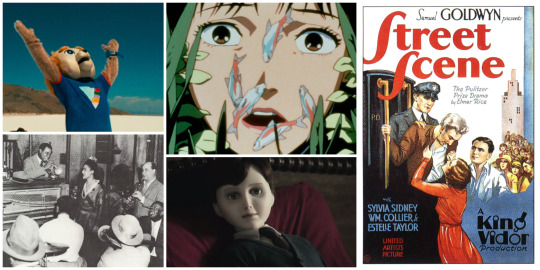
You should all be proud of me this month, as I actually watched MORE than one movie made in this decade. There was little rhyme or reason to the films I watched this month. I was pretty scattered honestly and my viewing habits show it. I keep a full diary on letterboxd and IMDB.
A major highlight of September was TCM’s month-long series hosted by the African American Film Critics Association (AAFCA) The Black Experience on Film. I only caught a few of the films but went out of my way to watch the introductory conversations. TCM’s Trailblazing Women series with Illeana Douglas was a favorite feature of mine and I’d love to see even more hosted series for marginalized groups in film history. It might be too much to suggest Disability on Film… But I’ve been considering doing a blogging series on that myself!
The reviews below the jump are essentially transcriptions of the notes I took right after watching the films. They’re presented in the order in which I watched them.
Brigsby Bear (2017)
23 January 2017 | 97 min. | Color

When Brigsby Bear came out there were a number of people, in real life and online, who gushed about it non-stop. I was pretty wary to see it. In the past, often when people around my age pick out a new darling film or TV series, I’ve been burned. Sometimes it’s something cynically violent in a way that’s disturbing to overlook. Sometimes it’s something with too much ironic detachment for my taste. Or it’s something straight-up ableist, sexist, or bigoted. (How are we still traumatizing all “Strong Female Characters” in the 2010s. Come on.)
BUT, Brigsby Bear was really good!? I honestly wasn’t expecting such a heartfelt and humanist film. A modern comedy movie that has faith in the good of all people? Amazing. I hope that the success of this film can be the beginning of a new chapter of millennial comedy so we can wholly move on from calling cynical intellectualized bigotry humor.
I got emotional as the friendship between Spencer and James developed. Maybe because I’m a clinically strange person myself. I don’t always have the energy in social situations to keep my neurotypical mask on and when I show my actually autistic self to people it doesn’t usually go all that well. That’s why it’s a special, joyful moment to find acceptance. Brigsby captures this so well. That feeling where people suddenly like you for your weirdness, rather than getting aggressive over it, is like a psychological hug. Kyle Mooney’s portrayal of James in those moments of acceptance is very true to life.
It’s refreshing to have the tension of a comedy film built around a feeling that misunderstandings might make everything fall to pieces. And then the tension releases because everyone is trying so hard to be their best self and things get sorted. I’m used to this dynamic in quite a few old romantic comedy films, but it’s a strategy not employed all that often today. If this is where millennial art is headed I’m ready to take out the trash marketed to us in the last decade.
At first I was worried that this was going to be another early 1980s throwback nostalgia piece without the spirit of media it was referencing (yes, I’m already fatigued by this). That thought was dispelled quickly.
The casting is great. The use of Mark Hamill is particularly ingenious.
Where to watch: it’s currently on demand through Starz.
Perfect Blue (1997)
28 February 1998 | 81min. | Color

Perfect Blue is a must-see for giallo fans, I think. It was very cool to see a Japanese filmmaker create a giallo-inspired psycho-detective thriller and specifically to see Satoshi Kon’s take given his skill in weaving tales about identity.
Perfect Blue is a harsh criticism of Idol culture (and, more broadly, fan culture).
This film requires a huge content warning for sexual violence and assault. If I hadn’t been watching Perfect Blue in a theater, I absolutely would have had to pause the film and take breaks a few times. Which is why, if you haven’t seen any other Kon films, it might be best to start elsewhere–even though Perfect Blue was his first feature. My first exposure to Kon was a few years back with Millennium Actress (2001) and then Paprika (2006). Both are great for newcomers to Kon. Paprika is usually the easy to find. Tokyo Godfathers (2003) is also worth watching, but pretty far afield from Perfect Blue.
Now I’m not suggesting that Perfect Blue isn’t good. It’s great. It’s simply that it’s such an intense and potentially triggering film that it might put some people off Kon’s other work. That may well have happened to me if this had been the first Kon film I saw rather than my last of his filmography.
As with Kon’s other films, the animation is fantastic and imaginative. I don’t want to give too much away about the story, so feel free to ask if you need more specific content warnings.
Where to watch: This one’s not so easy to get your hands on. Your local library or video store might be the best place to look. But, GKids does have some theatrical screenings upcoming.
New Orleans (1947)
18 April 1947 | 90min. | B&W
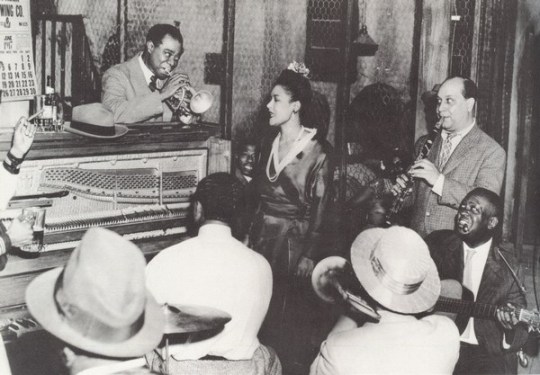
I watched this film on TCM as part of the aforementioned Black Experience on Film series with AAFCA.
As it was a month-long series in September, I probably should have mentioned it sooner, but the whole series was fantastic. The critics offered useful context for all of the films. Given that the films elicit mixed responses and have complicated roles in cultural and social history, it was very cool to see people debate and disagree on the films. It was valuable to witness even the disagreements that weren’t all that complicated and more about personal taste than politics. With New Orleans for example, one of the hosts liked the film and the other disliked it, though both held an appreciation for it. More civil disagreement about films, please and thanks.
I liked New Orleans and am disappointed that I hadn’t even heard about it before. Although, I do agree with critic/host Jamaal Finkley that it’s a disappointment that New Orleans doesn’t provide any insight into the personal trials of the Black characters.
It’s always a treat to see Arturo de Cordova, but that goes double when it’s an American film where his role isn’t informed by Latin/Mexican stereotypes. This is actually one the more refreshing aspects of the film. The Black characters lack interiority and their struggles are left out of the film, but Louis Armstrong’s and Billie Holiday’s characters are average people and don’t hew to stereotypes. It’s not exactly a victory for representation, but it’s still an improvement.
That said, the music is great and I wish there were more of it. It’s well established in the film that New Orleans’ problems largely come from badly-behaved white people, which I appreciate. (Is that too real?) Arturo de Cordova is great as the romantic lead of the film. I only wish Dorothy Patrick had the charisma to seem like a better match for him.
New Orleans is definitely worth checking out if the progress of Black representation in film is of interest to you or if you have a special interest in jazz or New Orleans.
Where to watch: It looks like Kino’s DVD release might be out of print, so libraries & video stores might be your best bet. OR, you can wait until TCM plays it again.
The Boy (2016)
22 January 2016 | 97min. | Color

Sooooo depending on how long you’ve been following the blog, you may or may not know that I love horror movies and ghost stories and whenever those things meet. When I first saw the trailers for The Boy ahead of its theatrical release, it did pique my interest. However, that’s mostly because they made me laugh. I am not someone who’s creeped out by dolls though. If you are, I suspect this film actually might be scary to you.
The Boy has a solid premise. At first it reminded me of the story “Baby Doll” by Larry LeClair from the radio show Nightfall. (”Baby Doll” is a better story, FYI, and creepier.) Unfortunately, the execution of The Boy’s story was disappointing. The film drags when it shouldn’t and the flow of the lead character warming to the doll felt stilted. The Boy’s big reveal ended up feeling a bit cheap as a consequence.
That said, I had fun watching it. I got some good laughs from Brahms’ ghostly antics and the middle part of the film is chock full of them.
The house from the film is so beautiful. I can’t believe it’s in Vancouver. Or that it’s a location for Little Women (1994)? I somehow didn’t recognize it.
Whether The Boy is worth a watch is debatable. If you like Haunted Doll stories, the execution and ending might be unsatisfying for you. Maybe if you like the odd modern horror film that can’t embrace its own camp, The Boy would be perfect for you?
Where to watch: It’s currently streaming on Netflix.
Street Scene (1931)
5 September 1931 | 80min. | B&W

This movie was a good old kick in the pants.
Street Scene an adaptation of a Pulitzer-Prize-winning stage play by Elmer Rice. It depicts the problems of New York City tenement residents and their relationships with one another. Though this is a pre-code film, I still imagine there would have been notable changes for censors. That said, the film is still very… mature. Additionally, I’ve seen suggestions that the film we know today is a re-edit of the film for post-code re-release. Hoo boy, what that source material must have been then.
One challenge a lot of filmmakers have when adapting stage plays to film is avoiding static staging–as if someone simply recorded the play. Street Scene doesn’t fear this and I think it works out. Almost all of the film takes place on the stoop of the tenement. The building facade is a truly impressive setup for filming. The camera work livens up the visuals with tracking shots and unexpected angles not commonly seen in early-sound films. (Unsurprisingly, Gregg Toland worked on the film!)
The acting is fantastic and, as someone who has spent the lion’s share of her life in cultural melting pots, the atmosphere the actors create is very authentic. Frankly, after living in Brooklyn for five years (four years ago), some neighborhoods still feel like this–only the voices are Puerto Rican and West Indian instead of European. It’s fascinating to see those veins of permanence in a city that’s changed as much as New York has.
The story primarily focuses on one family. The matriarch (Estelle Taylor) is bored with her unhappy marriage and takes up with the man who collects payment for milk delivery. The eldest child, Rose (Silvia Sydney), is pursued by seemingly every young, eligible man on the block and her not-so-young and not-so-eligible boss. The only one Rose shares feelings for is her downstairs neighbor, an unemployed student, Sam (William Collier, Jr.), who also happens to be Jewish. There is plenty of external resistance to their relationship for anti-semitic and/or financial reasons. Rose’s misgivings are a little more complicated. She feels trapped by the neighborhood and is wary to tie herself down to her current status at so young an age, regardless of how she feels about Sam. In the end, Rose’s mother’s fate cements her own. You can’t help but feel for both of them.
In case you haven’t already gathered this, the film calls for a content warning for anti-semitism and the use of anti-semitic slurs. [Note for clarification: the film is not anti-semitic, a few of the characters are.]
Street Scene takes social issues head on and is a pre-code through and through. It’s absolutely a top recommendation if you like pre-codes. It’s also worth watching if you’re into New York City history or have an interest in film adaptations of stage plays.
Where to watch: This one is pretty easy to see, but I haven’t sussed out the distribution rights or home video releases.
I also watched the film Sanatorium pod Klepsydrą / The Hourglass Sanatorium (1973). That left me with too many feelings to put in an amalgam post. Once I sort through how personal I want to get in discussing the film publicly, you can be sure it’ll get its own post up here.
Last Month’s Review
#Film Review#film blog#month in review#monthly roundup#brigsby bear#2010s#2017#comedy#perfect blue#satoshi kon#animation#animated movies#anime#giallo#horror#Horror Movies#horror film#suspense#1990s#1997#1998#new orleans#1940s#1947#Louis Armstrong#billie holiday#Arturo De Cordova#romance#2016#ghosts
10 notes
·
View notes